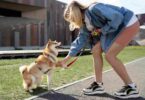Clicker training—an innovative method rooted in the principles of operant conditioning—is more than just a way to teach dogs new tricks. It’s a precise and effective tool for shaping behavior, enhancing communication, and fostering a deeper bond between you and your pet. With its distinct click sound signaling a reward-worthy behavior, this technique offers a level of clarity and consistency that is hard to match. Whether you’re teaching your dog basic commands, curbing undesirable habits, or fine-tuning more complex behaviors, clicker training can be an absolute game changer.
1. The Science Behind Clicker Training: Precision and Timing
Clicker training operates on the fundamental principle of positive reinforcement: rewarding the desired behavior to increase the likelihood of it being repeated. The clicker, a small handheld device that produces a sharp, distinct sound, acts as a marker. It signals to your dog that they’ve done something right. This immediate feedback helps to eliminate confusion, allowing your dog to associate the correct behavior with the reward much more quickly than with verbal praise alone. Timing is critical here—when your dog performs a behavior correctly, the click must happen immediately, reinforcing the action before they have a chance to forget what prompted the reward.
Unlike verbal commands, the click is a precise, consistent cue that doesn’t vary from one situation to another, making it easy for your dog to understand exactly what behavior is being reinforced. Over time, this clarity helps build a strong foundation for learning, as dogs quickly realize that the click signals something positive is coming their way. The key is to maintain sharp timing and consistency, ensuring that the clicker remains a clear signal of reinforcement.
2. Shaping Behavior: A Gradual Process of Successive Approximation
Clicker training shines in its ability to shape behaviors gradually, through a process known as successive approximation. Rather than waiting for the perfect, final behavior, you reinforce incremental steps toward the desired action. For instance, if you’re training your dog to sit, you might initially reward them for simply looking at the sitting position. Gradually, you reward them for bending their knees, then for sitting down fully. Each click marks a closer approximation to the final behavior you want, breaking the task down into manageable steps. This allows your dog to learn at their own pace, reducing frustration and making the process more enjoyable for both of you.
3. Creating a Positive Learning Environment: Motivation Through Rewards
One of the most powerful aspects of clicker training is the use of rewards. Unlike traditional punishment-based methods, clicker training is rooted in motivation, not fear. Every time your dog hears the click, they know something pleasurable is on the way—whether it’s a tasty treat, a favorite toy, or verbal praise. This encourages your dog to stay motivated, engaged, and excited about the training process. By using rewards that are meaningful to your dog, you ensure that the learning experience is not only effective but also enjoyable.
However, the key to success lies in selecting the right rewards for each individual dog. Some dogs may respond better to food rewards, while others may prefer toys or affection. Observing your dog’s preferences and using them as motivators helps keep their attention focused and speeds up the learning process.
4. Refining Complex Behaviors: From Simple to Advanced
While clicker training is often associated with teaching basic commands like “sit” or “stay,” it’s also highly effective for more complex behavior shaping. Want your dog to learn how to fetch a specific item or perform an intricate trick? Clicker training is perfect for these tasks, as it allows you to break down the sequence of behaviors required to accomplish the action and reinforce them at each step.
Take, for example, teaching your dog to open a door. You can start by rewarding them for approaching the door, then gradually click for reaching up to touch the handle, and eventually, for pulling the handle to open it. Each step is marked by the click, reinforcing the behavior and shaping it into the desired outcome. This technique is ideal for tasks that involve multiple steps or precise movements, where clarity and consistent reinforcement are crucial.
5. Addressing Problem Behaviors: Redirecting with Clicker Training
Clicker training is not just for teaching new behaviors—it’s also an effective tool for redirecting unwanted behaviors. If your dog has developed a bad habit, such as excessive barking or jumping up on people, clicker training can help. By focusing on what you want your dog to do instead of punishing them for the unwanted behavior, you create a more positive and productive environment. For instance, if your dog is barking at the door, you might click and reward them when they stop barking and sit calmly instead. This teaches your dog the behavior you want them to engage in, rather than reinforcing the negative behavior.
Redirecting behaviors using clicker training is highly effective because it encourages dogs to make good choices on their own. They start to understand that calm behavior is more rewarding than reacting impulsively, leading to more desirable patterns of conduct in the long term.
6. Generalization: Ensuring Consistency Across Environments
One of the challenges in dog training is ensuring that the behaviors your dog has learned in one environment transfer to other settings. For example, a dog may sit perfectly on command in the living room but forget the command when outside. This phenomenon is known as generalization, and clicker training can help address it. By practicing in different locations, with different distractions, and under varying circumstances, you help your dog generalize the behavior. Each click and reward reinforces the behavior regardless of where it takes place, helping your dog learn that sitting is always the right choice, whether at home or at the park.
7. Building Stronger Bonds: Clicker Training as a Relationship-Building Tool
Clicker training is more than just an educational tool—it’s a relationship-building experience. By working together to shape behaviors, you and your dog form a deeper bond rooted in trust and mutual understanding. Your dog learns to trust you as a source of guidance, and you learn to better understand your dog’s needs, preferences, and capabilities. The joy of seeing your dog succeed, of sharing those moments of mutual achievement, strengthens your connection, turning training into a rewarding experience for both of you.
8. Challenges and Pitfalls: Staying Consistent and Patient
While clicker training is a highly effective method, it does come with its challenges. The most significant one is maintaining consistency. Every click must be followed by an immediate reward, and this must be done consistently to prevent confusion. Furthermore, timing can be tricky—especially when working with high-energy dogs or during distractions. It’s important to stay patient and avoid rushing through the training process. Dogs need time to learn, and you need to be prepared for some trial and error. However, when done correctly, the rewards are immeasurable—not just in terms of behavior but in the bond you’ll share with your dog.



